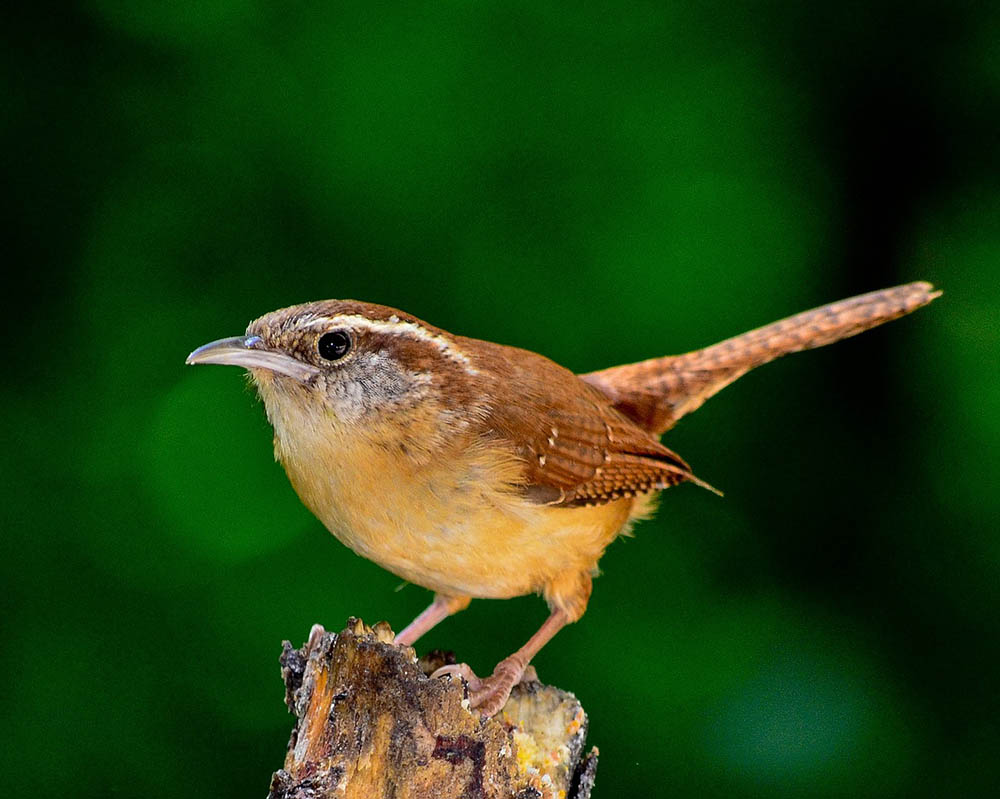Carolina Wren Male vs Female: How to Tell the Difference
Last Updated on

Male and female Carolina Wrens are similar in appearance, but there are important differences between the two that can help you determine which is which if you see one in the wild. If you are interested in learning more about these small birds, keep reading, as we list the visual and behavioral differences between the two sexes.

Visual Differences

At a Glance
- Average height (adult): 7–5.5 inches
- Average weight (adult): .6 –.8 ounces
- Average height (adult): 7–5.5 inches
- Average weight (adult): .6–.8 pounds

Carolina Wren 101
The Carolina Wren is a small, shy breed that you can find all over eastern and central United States. It can be hard to see due to its tendency to stay hidden. Still, you can easily hear its continuous singing, and it’s been wintering farther north over the past several decades, so its territory is expanding. Both the male and female Carolina Wren have a brown cinnamon color body with a small white eyebrow stripe and a long upward pointing tail.
Male Carolina Wren Overview
Personality / Character
The male Carolina Wren is a shy bird that spends most of his time undercover looking for food. He’s territorial and will aggressively protect his territory with loud singing and frequent movements until the threat moves. The male likes to sing and will produce a song nine to 11 times every minute while constantly bopping his head up and down.

Health & Care
The male Carolina Wren is a hardy bird that can survive in many different environments. During the spring and summer months, he catches live insects and other small animals to eat, but as soon as the weather turns cold, he switches to a seed diet and will be a frequent visitor to any backyard feeder as he gathers food. He also likes to take cover in nesting boxes when the temperature drops.
Breeding
The male Carolina Wren will build several dummy nests in the pair’s territory to give the female options. She will inspect each of them and choose her favorite. Then, the male will help her finish it and will do his part to feed the young when they arrive while protecting the nest.


Female Carolina Wren Overview
Personality / Character
The female Carolina Wren is shy, like her male counterpart. She also likes to sing but isn’t as loud as the male, and her song is different but fits perfectly with the male’s to make both resemble a single voice.

Health & Care
Like the male Carolina Wren, the female will gather insects and other small animals for food to stay healthy but will switch to a seed diet during the winter months and visit backyard feeders.
Breeding
After the female Carolina Wren selects one of the male’s nests, she will help him complete it before laying her eggs. She usually produces four to seven brown and speckled eggs that she will incubate for 12 to 16 days while the male brings food. When the eggs hatch, both parents feed the young for about 2 weeks. Then the children move on, and the parents start to build a new nest.
These birds tend to be successful at feeders because they are aggressive and will scold and chase away the other birds.

Other Interesting Facts About the Carolina Wren
- These birds like to make nests in unusual places, and if you have them near your home, you might find a nest in your mailbox, flower pots, and even in your shoes and pockets if they have access.
- You can invite Carolina Wrens to live on your property by setting up a nesting box that’s 3 to 6 feet off the ground.
- The nesting box can also help provide shelter during cold or extreme weather conditions, so if you install one, leave it up throughout the winter.
- The Carolina Wren is sensitive to cold weather. You will notice the population decrease after a severe winter, causing many people to suspect that the bird’s recent expansion north is due to a warming environment.
- The male and female Carolina Wren mate for life, and DNA testing suggests that they rarely cheat, making them a truly monogamous species.

Final Thoughts
The Carolina Wren is not a house pet, so you must venture out into their territory to find one. Its habitat covers most of the eastern United States, but it can be challenging to spot one at certain times of the year because these birds are shy. However, you will often hear them singing at other birds invading their territory in an aggressive attempt to get them to leave, which can give away their location. It’s also easy to see them in winter if you have a backyard feeder where they can eat at or even better, a nesting box that they can use for shelter from the cold.
Featured Image Credit: (L) Raul Baena, Shutterstock | (R) Chase D’animulls, Shutterstock
About the Author Ed Malaker
Ed Malaker is a veteran writer who contributes to a wide range of blogs covering information on computer programming, pets, birding, tools, fitness, guitars, and optics. Outside of writing, Ed is often found working in the garden or performing DIY projects in the house. Ed is also a musician, spending his time composing music for independent films or helping people repair their guitars.
Related Articles:
Monocular vs Telescope: Differences Explained (With Pictures)
10 Types of Hummingbirds in Arkansas (With Pictures)
8 Types of Hummingbirds in Nebraska (With Pictures)
5 Types of Hummingbirds in Idaho (With Pictures)
3 Types of Hummingbirds in Mississippi (With Pictures)
8 Types of Hummingbirds in Kansas (With Pictures)
5 Types of Hummingbirds in West Virginia (With Pictures)
5 Types of Hummingbirds in Ohio (With Pictures)
